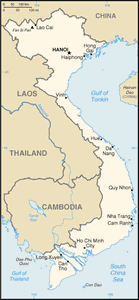The Geography of Vietnam
The Geography of Vietnam
Vietnamese Geography
Location: Southeastern Asia, bordering the Gulf of Thailand, Gulf of Tonkin, and South China Sea, alongside China, Laos, and Cambodia
Geographic coordinates: 16 10 N, 107 50 E
Map references: Southeast Asia
Area: total: 329,560 sq km land: 325,360 sq km water: 4,200 sq km
Area - comparative: slightly larger than New Mexico
Land boundaries: total: 4,639 km border countries: Cambodia 1,228 km, China 1,281 km, Laos 2,130 km
Coastline: 3,444 km (excludes islands)
Maritime claims: territorial sea: 12 nm contiguous zone: 24 nm exclusive economic zone: 200 nm continental shelf: 200 nm or to the edge of the continental margin
Climate: tropical in south; monsoonal in north with hot, rainy season (May to September) and warm, dry season (October to March)
Terrain: low, flat delta in south and north; central highlands; hilly, mountainous in far north and northwest
Elevation extremes: lowest point: South China Sea 0 m highest point: Fan Si Pan 3,144 m
Natural resources: phosphates, coal, manganese, bauxite, chromate, offshore oil and gas deposits, forests, hydropower
Land use: arable land: 20.14% permanent crops: 6.93% other: 72.93% (2005)
Irrigated land: 30,000 sq km (2003)
Natural hazards: occasional typhoons (May to January) with extensive flooding, especially in the Mekong River delta
Environment - current issues: logging and slash-and-burn agricultural practices contribute to deforestation and soil degradation; water pollution and overfishing threaten marine life populations; groundwater contamination limits potable water supply; growing urban industrialization and population migration are rapidly degrading environment in Hanoi and Ho Chi Minh City
Environment - international agreements: party to: Biodiversity, Climate Change, Climate Change-Kyoto Protocol, Desertification, Endangered Species, Environmental Modification, Hazardous Wastes, Law of the Sea, Ozone Layer Protection, Ship Pollution, Wetlands signed, but not ratified: none of the selected agreements
Geography - note: extending 1,650 km north to south, the country is only 50 km across at its narrowest point


